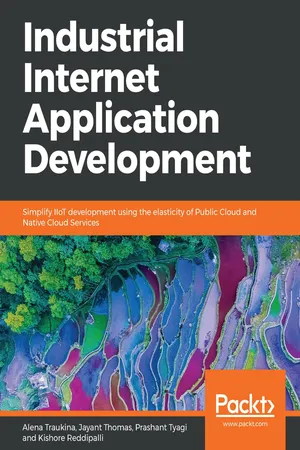
Industrial Internet Application Development
Simplify IIoT development using the elasticity of Public Cloud and Native Cloud Services
Alena Traukina, Jayant Thomas, Prashant Tyagi, Kishore Reddipalli
- 412 pages
- English
- ePUB (adapté aux mobiles)
- Disponible sur iOS et Android
Industrial Internet Application Development
Simplify IIoT development using the elasticity of Public Cloud and Native Cloud Services
Alena Traukina, Jayant Thomas, Prashant Tyagi, Kishore Reddipalli
À propos de ce livre
Your one-stop guide to designing, building, managing, and operating Industrial Internet of Things (IIoT) applications
Key Features
- Build IIoT applications and deploy them on Platform as a Service (PaaS)
- Learn data analytics techniques in IIoT using Spark and TensorFlow
- Understand and combine Predix services to accelerate your development
Book Description
The Industrial Internet refers to the integration of complex physical machines with networked sensors and software. The current growth in the number of sensors deployed in heavy machinery and industrial equipment will lead to an exponential increase in data being captured that needs to be analyzed for predictive analytics. This also opens up a new avenue for developers who want to build exciting industrial applications.
Industrial Internet Application Development serves as a one-stop guide for software professionals wanting to design, build, manage, and operate IIoT applications. You will develop your first IIoT application and understand its deployment and security considerations, followed by running through the deployment of IIoT applications on the Predix platform. Once you have got to grips with what IIoT is, you will move on to exploring Edge Development along with the analytics portions of the IIoT stack. All this will help you identify key elements of the development framework, and understand their importance when considering the overall architecture and design considerations for IIoT applications. By the end of this book, you will have grasped how to deploy IIoT applications on the Predix platform, as well as incorporate best practices for making fault-tolerant and reliable IIoT systems.
What you will learn
- Connect prototype devices to CloudStore data in IIoT applications
- Explore data management techniques and implementation
- Study IIoT applications analytics using Spark ML and TensorFlow
- Deploy analytics and visualize the outcomes as Alerts
- Understand continuous deployment using Docker and Cloud Foundry
- Make your applications fault-tolerant and monitor them with New Relic
- Understand IIoT platform architecture and implement IIoT applications on the platform
Who this book is for
This book is intended for software developers, architects, product managers, and executives keen to gain insights into Industrial Internet development. A basic knowledge of any popular programming language such as Python will be helpful.
Foire aux questions
Informations
Implementing IIoT Applications with Predix
- Using the Asset service for asset modeling
- Creating an instance of the Asset service and binding it to your app
- Configuring client authentications for managing assets via the Asset service
- Adding assets to the Asset service
- Changing assets
- Viewing, deleting, and querying assets
- Additional capabilities of the Asset service
- Building an app to read time series data
- Creating an instance of the Time Series service
- Binding an instance of the Times Series service to your app
- Validating ingestions of time series data
- Components and capabilities of the Analytics Framework service
- Creating an instance of the Analytics Framework service and binding it to your app
- Building an analytical app to work with the Analytics Framework service
- Adding an analytical app to the Analytics Catalog of the Analytics Framework service
- Validating, testing, and deploying an analytical app
- Executing an analytical application
- Enabling data visualizations with GE's Predix UI Framework
Basics of asset modeling with the Asset service
The Asset service in detail
An example of a classification object

[
{
"uri": "/countries",
"name": "Countries",
"obsolete": false,
"attributes": {
}
},
{
"uri": "/countries/USA",
"name": "USA",
"parent": "/countries",
"obsolete": false,
"attributes": {
}
},
{
"uri": "/countries/Japan",
"name": "Japan",
"parent": "/countries",
"obsolete": false,
"attributes": {
}
}
]